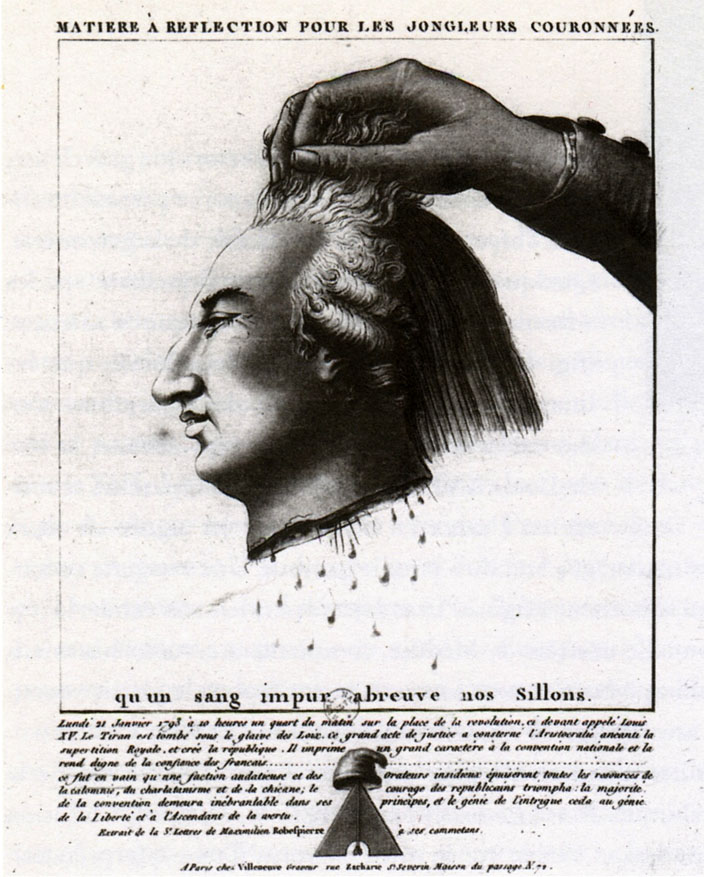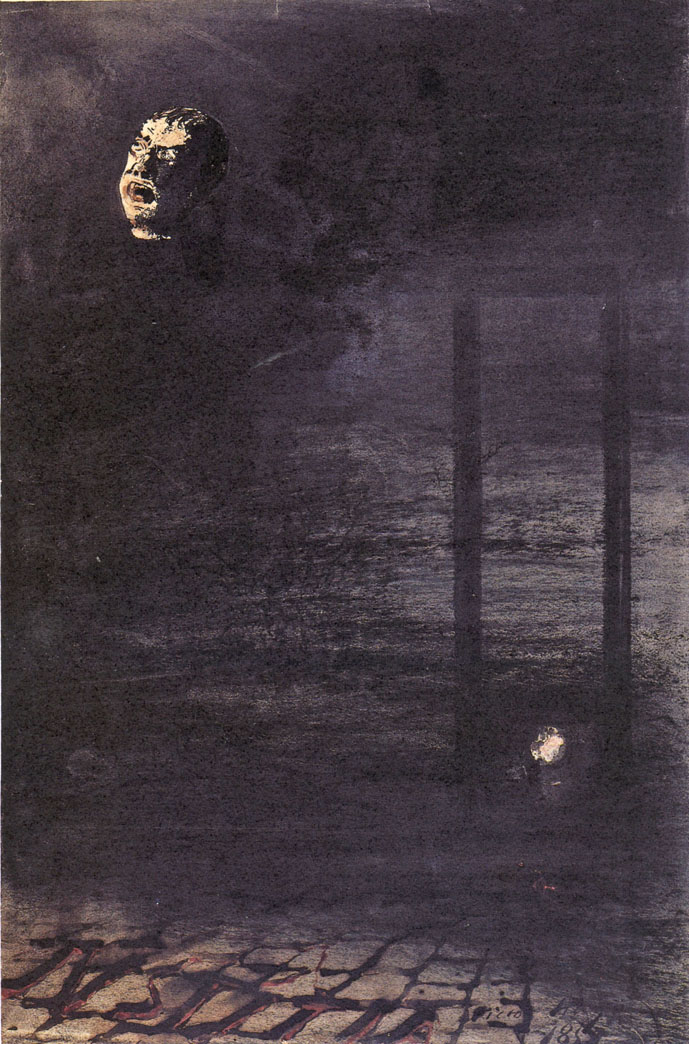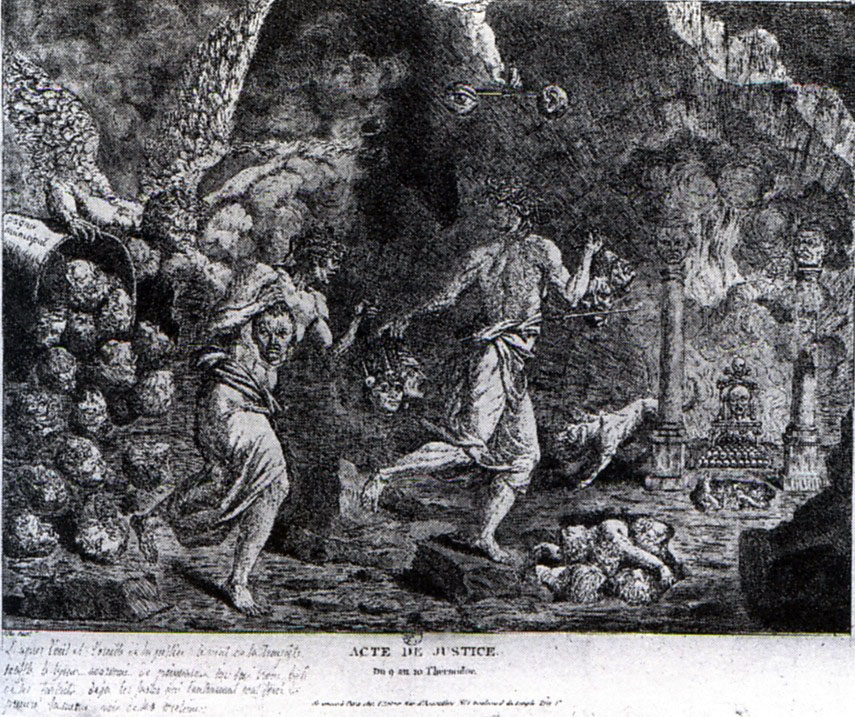I used to use Michel Foucault as the password for every one of my internet accounts. Then, probably the doing of that wily crazy lady over at drphil.com -- you know the one, I got hacked to pieces. So I switched to Julia Kristeva.
I'm going to blame it on the drugs. I thought she was dead. But she's looking awfully chic, with adequate blood flow, and is only in her 70s. She is one of my favorite people but I had put my "connaissance" in stasis, just sort of stopped reading her, stopped learning.
This represents one of the more wonderful, even if humiliating, aspects of Twitter. An artist that I "follow" retweeted something from Kristeva's account. "Harrumph," I snorted. [In case you did not know the organic steps necessary to the creation of a/an harrumph -- "a/an" depending on whether you choose the "'h'-aspiré" or not.
Think back to French One and "un homme" vis-à-vis "un héros."]
That harrumph-snort came from my certitude that she was dead. Duh.
Anyway, she has done a nice piece on the death penalty. If you are a regular Dear Reader, you know that I am a longtime death penalty abolitionist, and consider the USA as yet uncivilized, at the very least, for not yet having done away with it. I also no longer fight with people about it, rarely going beyond stating my opinion. But that doesn't preclude forwarding to you a work with which I agree (mostly -- I am considerably more intense and clear in my opinions than Kristeva) by someone whom I greatly admire. Well, more clear. She might have me beat in the intensity department.
[What the heck. I toss this out into the info-sphere and remind you that there will be a fourth vote at the UN General Assembly this December on the imposition of a moratorium on the use of the death penalty. I know, I know, don't even bother me with the comebacks. Just don't. Just check out THIS WEBSITE, maybe sign a petition and be quiet: The last vote garnered this result: 109 votes in favour, 41 voted against and 35 abstained. The first attempt, in 2007? 104 UN members states voted in favor, while 54 voted against and 29 abstained. Change, like peace, "comes dropping slow." Apologies to Yeats.]
Even if I thought she was dead. If you don't speak French, take a few minutes and learn some, or use one of the wunnerful, wunnerful translators available on the web. At least watch the video! There was a time I'd not hesitate to translate the piece... but this is Kristeva, folks. I'm not going to risk screwing up something by her!
Aw, man. She's giving a doctoral seminar on Colette at Université Paris Diderot-Paris 7, open to the public. I guess it is probably over, as it began in January. But shoot, you know?
You know, I think these meds are working. Even though I'm seeing double and am somnolent to the tune of Rip Van Winkle, I have developed the itch, the urge, the longing to... stroll the Boulevard Saint Germain, taking a right onto the Rue des Fossés Saint Bernard, for a late morning of "La révolte intime : Colette."
View Larger Map
So here she is, all my ado aside, her work stolen in its entirety from her "
site officiel," but with so much respect that I hope not to be sued,
simper-simper-respect-awe-simper:
De l’inviolabilité de la vie humaine
10 octobre 2012 : dixième journée mondiale pour l’abolition de la peine de mort. Mobilisation, ignorance, hostilité, incompréhension, solennité et gravité suspendent le temps de la crise mondiale, de l’accélération hyperconnectée et des diverses menaces de destruction. Et appellent au recueillement, invitent à la méditation, au questionnement : quel est le sens d’un projet d’abolition universelle de la peine de mort?
I.
Je ne suis ni juriste ni spécialiste de l’abolitionnisme. Je n’ai jamais assisté à une exécution, et aucun de mes proches ne fut victime de meurtres, d’abus sexuels, de tortures ou de violences dégradantes. Je ne vous lirai pas ces rapports médicaux détaillant les supplices de la guillotine, que Camus lui-même recopiait pour nous communiquer sa nausée. Je n’ai pas non plus ressenti cette empathie romantique qui emporte Hugo, comparant sa douleur d’exilé à celle du proscrit. J’estime que les douleurs sont incommensurables, plutôt incommunicables, et que la pulsion de mort qui nous habite nous menace tous... au singulier.
J’entends mes analysants me confier les souffrances qu’ils ont endurées aux mains des bourreaux dans les prisons d’Amérique Latine, ou leur inconsolable douleur après l’extermination de leurs parents dans les camps de concentration. Je me défais avec eux, et je ne m’aventurerai pas à dire que le mal est sans pourquoi, comme le mystique affirme que la rose n’en a pas. Car je cherche pour eux, avec eux : pourquoi ? Afin que le sens revienne, car le sens nous fait reprendre vie.
Abolir la peine de mort : quel vœu, quel projet portons-nous ici ? Et quel en est donc le sens?
Abolir la peine de mort signifie que nous posons comme fondement de l’humanisme du XXIe siècle ce que Victor Hugo appelait il y a plus de cent cinquante ans déjà (en 1854) : « l’inviolabilité de la vie humaine ».
Depuis toujours, les hommes ont peur de la mort, ils la donnent pourtant, pour mieux sauvegarder la vie, et tentent de sauver le bien en infligeant le mal suprême. Pour la première fois dans l’histoire, cependant, nous réalisons qu’il ne suffit pas de remplacer les anciennes valeurs par de nouvelles, car celles-ci se figent à leur tour en dogmes et impasses, potentiellement totalitaires. Et que la vie n’est pas une « valeur» comme les autres, ni même LA valeur. Plus encore, depuis deux siècles, et particulièrement aujourd’hui, elle est non seulement une interrogation : qu’est-ce qu’une vie ? a-t-elle un sens ? si oui lequel ? Mais la vie est désormais une exigence : il faut la préserver, et empêcher sa destruction – car la destruction de la vie est le mal radical. Alors que tout semble s’écrouler et que les guerres, la menace de désastre écologique, l’emballement de la finance virtuelle et la société de consommation, nous rappellent en permanence à notre fragilité et à notre vanité, c’est l’inviolabilité de la vie humaine qui nous invite à penser le sens de notre existence : elle est la pierre angulaire de l’humanisme.
 |
Tête coupée de Louis XVI
|
De quelle VIE parle-t-on ? L’abolitionniste répond : TOUTE VIE, quelle qu’elle soit, jusqu’à « assumer la vie de ceux qui font horreur » - les déments, les criminels -, proclamait Robert Badinter en déposant en 1981 devant le Parlement français, un Projet de Loi pour l’abolition de la peine de mort. L’humanité actuelle peut-elle s’éprouver, et se prouver, jusqu’au point d’« assumer la vie de ceux qui font horreur » ? Abolitionnistes, nous disons : oui. Bien que, même si 141 pays sur 192 membres de l’ONU ont déjà aboli la peine de mort, 60 pour cent de la population humaine vive dans un pays où elle s’applique encore ( puisqu’elle est en vigueur dans 4 des pays les plus peuplés de la planète : Chine, Inde, États-Unis, Indonésie).
Forte de son héritage pluriel – grec, juif et chrétien - l’Europe fit le choix de la sécularisation, opérant ainsi une mutation émancipatrice unique au monde ; mais son histoire fut aussi marquée par son trop long cortège d’horreurs - guerres, exterminations, colonialisme, totalitarismes. Cette philosophie et cette histoire nous imposent une conviction politique et morale selon laquelle aucun État, aucun pouvoir, aucun homme ne peut disposer d’un autre homme et n’a le droit de lui retirer la vie. Quel que soit l’homme ou la femme que nous condamnons, aucune justice ne doit être une justice qui tue.
Plaider pour l’abolition de la peine de mort au nom du principe de l’inviolabilité de la vie humaine ne relève donc ni de la naïveté, ni d’un idéalisme béat et irresponsable, il ne s’agit pas non plus d’oublier les victimes et la douleur de leurs proches. NON. Je ne crois ni à la perfection humaine ni même à la perfectibilité absolue, par la grâce de la compassion ou de l’éducation. Je parie seulement sur notre capacité à mieux connaître les passions humaines, et à les accompagner jusqu’à leurs limites, car l’expérience nous apprend qu’il est impossible (impensable) de répondre au crime par le crime.
Je le répète : l’humain n’a pas de plus grande peur que celle de se voir retirer la vie, et cette peur fonde le pacte social. Les plus anciens traités de jurisprudence que nous possédons en témoignent. Prenez le code babylonien Hammurabi (1792-1750 avant notre ère), ou encore la philosophie grecque de Platon et d’Aristote, mais aussi chez les Romains, et aussi les livres sacrés des juifs et des chrétiens : toutes les sociétés ont plaidé et pratiqué la mise à mort du criminel afin de défendre, protéger et dissuader.
Des voix se sont cependant élevées contre la mise à mort : les abolitionnistes actuels les retrouvent et les entendent pour étayer leur combat. Ainsi, déjà, Ezéchiel : « Je ne prends point plaisir à la mort du méchant, mais à ce que le méchant se détourne de sa vie et qu’il vive » (Ez, 33:11) ; mais surtout Saint Paul : « Mort, où est ta victoire? Où est-il, ô mort, ton dard venimeux ? La mort a été engloutie dans la victoire ! » (de la Résurrection) (I Ep.Cor.). Ou encore, à leur suite, Maïmonide : « Il est plus satisfaisant d’acquitter des milliers de coupables, que de mettre à mort un seul vivant».
Rarement, les religions ou les politiques se sont prononcés contre la peine capitale: le bouddhisme tibétain l’interdit au VIIe siècle; et en 747, une première abolition fut proclamée en Chine, Montesquieu la signalera d’ailleurs, louant ces auteurs chinois selon lesquels « plus on augmente les supplices, plus la révolution était prochaine ; c’est qu’on augmentait les supplices à mesure qu’on manquait de mœurs ». Ne faudrait-il pas le rappeler aux autorités chinoises, aujourd’hui la Chine a supprimé la peine de mort en 2011 pour 13 crimes non violents, mais les exécutions se poursuivent et se multiplient pour corruption. Quant à l’Islam, il n’y est guère question de remettre en cause la peine de mort.
En France, le mouvement abolitionniste s’amorce après la torture de Damiens, qui avait tenté d’assassiner Louis XV. Alors que Diderot préconise la peine de mort pour son efficacité dissuasive, Voltaire est l’un des rares à soutenir l’œuvre de Cesare Beccaria qui, dès 1764, s’interroge : « En vertu de quel droit les hommes peuvent-ils se permettre de tuer leurs semblables ? ». Dans l’esprit des Lumières et celui de l’humanisme libertaire, l’abolitionnisme se développe tout au long du XIXe siècle - je pense à Clémenceau, Gambetta, et à ces lucides paroles de Jean Jaurès, proclamant que la peine de mort « est contraire à la fois à l’esprit du christianisme et à l’esprit de la République ». Ou, plus près de nous, à Camus qui constate que « de la peine capitale on n’écrit qu’à voix basse », car « le nouveau meurtre, loin de réparer l’offense faite au corps social, ajoute une nouvelle souillure à la première (…). « Le jugement capital rompt la seule solidarité humaine indispensable, la solidarité contre la mort. »
 |
Victor Hugo, Justitia
|
II.
Les abolitionnistes avancent trois arguments principaux contre la peine de mort : l’inefficacité de la vengeance et de la dissuasion ; la faillibilité de la justice ; la douleur piégée par l’élimination.
En premier lieu, rien ne prouve l’efficacité de la peine de mort contre la destructivité humaine : n’y a pas de corrélation entre le maintien de la peine de mort dans une législation et la courbe de la criminalité. De surcroît, la perspective de la mort, loin d’annihiler la passion criminelle, l’exalte au contraire. Celui qui sème la terreur et la transcende par sa propre mort, ne recherche pas l’expiation. La stigmatisation de ses actes et son sacrifice même n’ont en réalité d’autre fin qu’enflammer les martyrs prêts à mourir à leur tour. Loin d’être dissuasive, la peur devient tentation, et nourrit dès lors le désir d’infliger la mort en s’infligeant la mort. La peine de mort comme loi du talion s’avère donc inefficace aussi bien comme vengeance que comme dissuasion.
Le second argument renvoie à ce que Victor Hugo appelle la «brièveté chétive de la justice humaine » : la loterie judiciaire, sa faillibilité. Au nom de quoi, une institution, un homme ou une femme s’octroient-ils le droit de prononcer et faire appliquer une condamnation mortelle ?
Le troisième argument ne se dit qu’en murmure, car il s’adresse à la douleur des victimes et de leurs proches. D’aucuns estiment que même si la mise à mort du criminel ne venge pas son crime ni ne dissuade ceux qui lui succéderont, elle en supprime au moins l’auteur. La peine de mort comme élimination atténuerait par conséquent l’insoutenable, et apaiserait.
Mais l’image du criminel dans sa tombe soulage-t-elle vraiment la douleur de ceux qui ont perdu un proche, victime des pires atrocités? Cette douleur en quête d’apaisement est aussi inexprimable, impartageable que légitime et respectable: qui oserait l’ignorer? Personne, et surtout pas ceux et celles qui, indignés par la mort d’innocentes victimes, souhaitent également défendre et protéger la vie au nom de son inviolabilité. Car ils savent que la mort comme ultime et unique recours est un leurre.
Quand cesserons-nous en effet de faire du tombeau notre sauveur? Détachons-nous donc de la jouissance que provoque l’acte vengeur. Le verbe haut de Victor Hugo nous alertait déjà sur cette religion de la mort salvatrice : « N’ouvrez pas de vos propres mains une tombe au milieu de nous », écrit-il de Guernesey. «Hommes qui savez si peu de choses et qui ne pouvez rien, vous êtes toujours face à face avec l’infini et avec l’inconnu! L’Infini et l’inconnu, c’est la tombe». J’entends : N’espérer pas trouver « l’inconnu ou l’infini » dans le sacrifice du condamné. Et j’ajoute : il n’y a d’autre inconnu, ni d’autre infini que ceux des passions humaines, dont nous ne cessons d’approfondir l’expérience, et d’établir la connaissance.
En abolissant la peine de mort, nous ne crions pas victoire sur la mort, comme le voulait Paul de Tarse qui appelle à croire à la résurrection. Nous invitons à mieux connaître et accompagner les passions, et parmi elles, la plus terrible : la pulsion de mort.
III.
La psychanalyse découvre que l’Homo sapiens , qui est à la fois Homo Religiosuset Homo Economicus, est un Homo Eroticus non seulement habité par une pulsion de vie, mais aussi par une pulsion de mort. Celle que Freud - comme s’il pressentait la Shoah - explora à la fin de sa vie, et que la recherche contemporaine continue aujourd’hui à élucider.
L’être humain est un être fondamentalement binaire : digérant le bon et expulsant le mauvais, oscillant entre le dedans le dehors, plaisir et réalité, interdit et transgression, son moi et l’autre, le corps et l’esprit… Le langage lui-même est binaire (fait de consonnes et de voyelles, et autres formes duelles qui ont fait le bonheur du structuralisme…). Ainsi l’enfant accède-t-il à la différence entre le bien et le mal au moment même où il apprend la langue maternelle : l’univers du sens invite à distinguer le bien du mal, avant d’en affiner les nuances, d’en percevoir les polyphonies, les excès, les transgressions, ou d’en créer les œuvres d’arts.
Nos désirs se révèlent plus ou moins compatibles avec les désirs d’autrui. Ils nous tirent vers l’autre, jusque l’amour, mais un amour qui porte en lui l’agressivité : je t’aime, moi non plus, haine et culpabilité : telle est l’alchimie du verbe. C’est précisément sur ces intérêts libidinaux convergents et divergents, sous-tendus par nos conceptions du bienet du mal, que se construisent des valeurs plus élevées qui entrent alors en concurrence ou en conflit. Désirs et valeurs édictent les religions, les philosophies, les idéologies qui en vivent, s’entretuent, ou tentent de s’expliquer et de s’entendre.
Souvent, les « valeurs », comme on dit, capturent la destructivité. Celle-ci prend alors la forme d’une fascination pour le mal, un mal qui est à rechercher chez l’autre : il ne reste dès lors plus qu’à traquer le bouc émissaire pour l’exterminer sans remords, au profit du Souverain Bien, mon Bien à moi, ma religion. Telle est la logique de l’intégrisme, qui mène une guerre sans merci au nom d’un idéal absolu érigé contre celui d’en face. Qu’il soit individuel ou collectif, cet intégrisme se nourrit d’une foi totale et aveugle qui ne souffre aucun questionnement. Comme je l’affirmais préalablement, la condamnation à mort de l’intégriste, n’élimine pas l’intégrisme lui-même, bien au contraire, elle fait de son agent un martyre et exalte sa logique. Une logique qui a des racines économiques et sociales ; mais aussi une nervure psycho-sexuelle, par la structure même de sa passion, et elle reste imprenable si elle n’est pas désamorcée de l’intérieur.
Il ne s’agit pourtant ici que des couches superficielles du mal radical. Il existe également une pulsion de mort pure, dissociée de tout désir (on dira: désintriquée du désir). Cette pulsion de mort balaie la distinction entre le bien et le mal, entre moi et l’autre, elle abolit le sens et la dignité de l’autre et de soi. La destructivité que je viens de pointer cède ici à la déliaison. Ces états extrêmes de déliaison quasi-totale de la pulsion de mort touchent aux limites de l’Homo Sapiens comme être parlant et capable de valeurs (à commencer par le bien et le mal). La personne en proie à cette déliaison s’exprime dans un langage qui n’est plus que simple mécanique, instrument de destruction, sans code ni communication : sans pourquoi, sans remords, ni expiation ni rédemption.
De tels états limites ne se réfugient pas uniquement dans les hôpitaux ou sur les divans, ils ne sévissent pas uniquement chez les tueurs en séries, ni n’explosent brutalement que dans les chaos d’une adolescence vouée à l’indifférence et à l’insensibilité face à l’étranger à supprimer. Les états limites de la pulsion de mort déferlent aussi dans les crises et catastrophes sociopolitiques. Abjects, ces états peuvent conduire jusqu’à l’extermination froide et planifiée d’autres êtres humains : ce fut le cas avec la Shoah et autres génocides.
 |
Anonyme, Acte de justice du 9 au 10 Thermidor
|
IV.
J’entends votre question dont je partage l’indignation: et alors, les abolitionnistes veulent épargner la mort à ces criminels-là ?
Si j’ai conduit cette réflexion jusqu’à la déshumanisation, ce n’est que pour mieux démontrer que l’humanisme que revendiquent les partisans d’une abolition de la peine de mort est un pari contre l’horreur. La connaissance des passions humaines nous permet d’aborder ces états limites et de les accompagner sur un plan clinique, même si elle ne nous rend ni tout puissants ni capables d’annuler cette pathologie quand toute une société en souffre. Mais après Ezéchiel, Paul de Tarse et Maïmonide, après Beccaria, Voltaire, Hugo, Jaurès, Camus, Badinter et tant d’autres, il apparaît qu’une meilleure connaissance du spectre des passions humaines est le seul moyen de déceler et d’affronter les multiples visages de ce mal radical. Quand la compassion et le pardon abdiquent, car ils n’ont plus prise sur ce mal, il devient néanmoins possible de le sonder jusque dans ses profondeurs. Comment ?
En relayant l’émotion horrifiée par un diagnostic plus précis des ressorts complexes du mal radical. La vigilance, l’analyse objective, les soins et l’éducation n’effacent rien de la culpabilité des criminels : mais ils nous mobilisent dès les premiers symptômes;
En remplaçant la peine de mort par de rigoureuses peines de sûreté qui empêchent la récidive
Et enfin, en organisant l’indispensable accompagnement de ces personnes, condamnées de droit pénal ou criminels politiques, afin de les conduisant le plus loin possible dans leurs possibilités de restructuration, et tenter de mieux d’élucider les ressorts de la destructivité et de la déliaison génératrice du crime.
La philosophe et journaliste politique Hannah Arendt dénonçait l’horreur nazie comme un mal radical sans précédent, en soutenant cependant que ce n’est pas le mal, mais le bien qui est radical. Car le bien n’est pas un envers symétrique au mal, il réside dans les capacités infinies de la pensée humaine à trouver les causes et les moyens de combattre lemal-être et la malignité du mal.
 |
Andy Warhol, Chaise éléctrique, 1971
|
|
V.
Permettez-moi de finir sur un ton plus personnel.
Enfant en Bulgarie, mon pays natal, j’entendais mes parents évoquer les peines de mort que le régime communiste avait infligées au parlement précédent, mais aussi les procès et les purges staliniennes. J’apprenais déjà le français, quand mon père, homme de foi, m’expliquait que si la terreur révolutionnaire avait été inévitable, la langue, comme la culture française portaient aussi en elles la lumière. J’étais déjà en France quand il fut hospitalisé pour une opération bénigne, et assassiné dans un hôpital bulgare en 1989, quelques mois avant la chute du Mur de Berlin – on y faisait alors des expérimentations sur les personnes âgées. La peine de mort a été abolie en Bulgarie en 1998, bien qu’aujourd’hui encore, 52 pour cent des personnes interrogées dans ce pays se disent favorables à son application.
Il n’est pas question de sauver la société, qui ne se perpétue qu’en se verrouillant contre l’infinie complexité des passions. Mais de mettre nos connaissances des passions au service de l’humain, pour mieux nous protéger contre nous-mêmes. Le nouvel humanisme doit être en mesure de défendre le principe de l’inviolabilité de la vie humaine et de l’appliquer à tous, sans exception ; aussi bien qu’à d’autres situations extrêmes de l’expérience vitale: l’eugénisme, l’euthanasie… Loin de moi l’idée d’idéaliser l’être humain, ou de nier le mal dont il est capable. Nous pouvons toutefois le soigner et, en abolissant la peine de mort – qui est un crime, rappelons-le – nous nous battons contre la mort et contre le crime. À ce titre, l’abolition de la peine de mort est une révolte lucide, la seule qui vaille contre la pulsion de mort, et en définitive contre la mort: elle est la version sécularisée de la résurrection.
Vous savez sans doute que les Italiens illuminent le Colisée, sanglante mémoire d’innombrables gladiateurs et martyrs chrétiens mis à mort, à chaque fois qu’un pays abolit la peine de mort ou édicte un moratoire des exécutions.
Je propose que chaque nuit, où un pays renonce à la peine de mort, son nom s’inscrive sur un écran géant installé pour la circonstance sur la Place de la Concorde (ancienne place de la Révolution) et de l’Hôtel de Ville (ancienne Place de Grève), en souvenir de Madame Roland, de Madame du Barry, de Charlotte Corday, des tricoteuses, de la guillotine, de Fouquier-Tinville, d’André Chénier… Cette dépense supplémentaire risque-t-elle d’aggraver l’état de nos finances? Les optimistes prévoient que le monde dans sa quasi-totalité aura aboli la peine de mort en 2050. À nous de faire en sorte que cette abolition emporte l’adhésion de la majorité.
Julia Kristeva
3.10.2012











